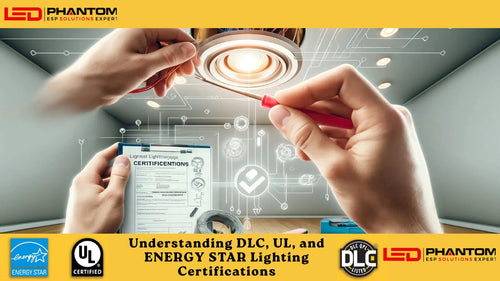High Bay Buying Guide | LED Phantom
Buying the right LED high bay light can mean the difference between saving or wasting billions of dollars a year. In commercial settings, especially, any time spent replacing faulty high bay lights means time and productivity lost. Your client needs fixtures that are built to last, to ensure operations continue to run as smooth as possible.
What Are LED High Bay Lights?
LED high bay lights are designed to provide clear and even light to areas with high ceilings. This includes warehouses, gymnasiums, and certain retail stores. A long lifespan, combined with energy efficiency, makes them a more desirable option than their fluorescent and incandescent options.
You might be wondering what the difference is between high bay and low bay lighting. Wonder no more. High bay lights are perfect for applications with ceilings that are 20-45 feet tall, while low bay lights are for ceilings that are between 12-20 feet high.
What Are the Benefits of High Bay Lights?
Besides clear, uniform lighting with little glare? Where do we start?
LOWER OPERATION & MAINTENANCE COSTS
LEDs have a lifespan of more than 50,000 hours, which is four to forty times as long as their conventional counterparts. Not only does this mean less expense over time on replacement bulbs, but it also means less time (and money) spent on actually changing the bulbs. Replacing high bay lighting bulbs often requires more time and special equipment, like scaffolding, catwalks and hydraulic lifts, to safely reach the light fixtures.
UNMATCHED LIGHTING PERFORMANCE
One of the biggest draws of LEDs is the exceptional light quality they offer. Light quality is determined by measuring the color rendering index (CRI), correlated color temperatures (CCT) and the foot candle of a light source. By all measures, LEDs outperform conventional light sources. They are able to reflect object colors faithfully (CRI) while offering versatility in color “temperature” (CCT) and impressive light efficiency (foot candle). In addition to this, LEDs are almost instantly on, as opposed to their traditional lighting counterparts, which can take as long as thirty minutes to reach full brightness.
ENERGY EFFICIENCY
The cost-saving energy efficiency of LEDs is often the driving factor for businesses to install high bay LED light fixtures. Losing only 5% of their energy to heat, LEDs require far less electricity to generate the same (or better) lumens per square foot (foot candles). In addition to this, most conventional warehouse and factory light sources are omnidirectional, which means they output light in all directions. Much of the light from conventional sources is pointed in areas that do not need direct illumination (like the ceiling). LEDs, on the other hand, waste less light by delivering direct light distribution. These two factors taken together make LEDs some of the most energy-efficient lighting options available.
What Are the Primary Types of LED High Bays?
Linear High Bay Lights
Linear high bay lights are commonly seen in grocery stores, wholesale retailers, warehouses, and any other wide-open spaces with a lot of aisles or shelving. They provide ideal lighting for conference halls, event centers and fitness centers, too. Similar in appearance to a fluorescent T8, linear high bays are long, with differing widths to offer rectangular illumination to suit your space’s needs. They can be mounted directly to the ceiling or hung with chains or cables, depending on your needs.
Round High Bay Lights
Commonly called UFO high bays because of their saucer-like shape, round LED high bay lights have only one contact point with the ceiling, making them the easiest high bays to install. Round high bay LED lights typically provide a circular light beam angle of about 120 degrees. This fairly large beam spread allows for widespread, but powerful, illumination. These are an excellent choice for open areas, like factories, warehouses, sports arenas, grocery and wholesale retailers, and even aircraft hangars.
Where Are High Bay Lights Most Appropriate?
WAREHOUSES
LED high bays ensure that warehouse operations run as smoothly as possible, with little to no interruption. They also emit less heat, which means less cooling costs for a facility. Uniform light levels make it easy to see inventory shelves from top to bottom.
AUTO AND METAL SHOPS
LED high bay lights bring out the true colors of everything underneath them. That includes making cars look their best, which entices potential customers to buy.
GROCERY STORES AND SUPERMARKETS
Crisp and clear LED lighting, featuring an 80+ CRI, makes the produce section of any grocery store look its best. Think of the strawberries, the raspberries, the fruit…each needs to be sold before they go to waste. And what better way to do it than with LED high bay lights?
How to Pick the Appropriate Wattage and Lumens
High Bay LED lights are available in different watts, but its the lumens you need to keep an eye on. As LEDs get more efficient, they will use less and less watts. You can easily choose one depending on the height where the high bay lights are installed. There are different watts for different levels of height:
- 10-15 feet – This height is ideal for lights with 10,000 to 15,000 lumens.
- 15-20 feet – This height is ideal for lights with 16,000 to 20,000 lumens.
- 25-35 feet – For this height, lights with 33,000 lumens are ideal.
SPACING
The spacing between lights is also an important factor in choosing high bay LED High Bay lights. There are three most common cases that you can consider to find the best light for your space. These are listed below:
- At 15 feet height, about 12 feet spacing is essential for a bright light. However, if you need normal light, a space of 15 feet should be present.
- At 20 feet high you can go to 15 feet spacing for generating bright light and if you need normal light, a spacing of 18 feet should be used.
- At 30 feet height, you can go for 20 feet spacing between the lights in order to get a brighter light. However, for normal light, you can go for 25 feet spacing.
NUMBER OF LIGHTS
After you’ve determined the spacing between the lights, you’ll need to figure out how many lights you’ll need. The number of lights depends on the available space. Using the spacing and quality of brightness you need, you can calculate the number of lights you’ll be needing for a particular space.
TYPE OF LIGHTS
High Bay lights are available in a range of shapes. We offer both round lights and LED Linear High Bay Lights. And some people might not know that if you hang round high bays a few feet higher, they might just spread out illumination the way you need it. Above about 15 feet, we recommend round high bays. Why? They’re easier to install. But in areas with aisles and lower heights, linear lights are ideal.
CROSSOVER LIGHTING
In order to get better light, you should have light coming from different directions. This is called crossover lighting and, ideally, it needs to come from at least 3 locations. This way, the light coming from opposite sides reduces shadows and evens the lighting. As a result, you get better light that avoids hot spots. You may have to plan for lower lumens but more fixtures to get the right combination.
LUMENS
Last but not least, you should always look for lumens, not watts. No matter how many watts you choose, if there aren’t enough lumens, you won’t be able to get the light you need.
LED Phantom
Need help picking the right LED high bay for you? We have lighting experts available to you at 630-225-9300. Give them a ring or click here. They’re happy to help.


